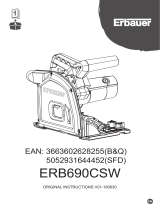
ENGLISHen
10
c) When restarting a saw in the workpiece,
centre the saw blade in the kerf so that the saw
teeth are not engaged into the material. If a saw
blade binds, it may walk up or kickback from the
workpiece as the saw is restarted.
d) Support large panels to minimise the risk of
blade pinching and kickback. Large panels tend
to sag under their own weight. Supports must be
placed under the panel on both sides, near the line
of cut and near the edge of the panel.
e) Do not use dull or damaged blades. Unsharp-
ened or improperly set blades produce narrow kerf
causing excessive friction, blade binding and kick-
back.
f) Blade depth and bevel adjusting locking
levers must be tight and secure before making
the cut. If blade adjustment shifts while cutting, it
may cause binding and kickback.
g) Use extra caution when sawing into existing
walls or other blind areas. The protruding blade
may cut objects that can cause kickback.
4.3 Lower guard function
a) Check the lower guard for proper closing
before each use. Do not operate the saw if the
lower guard does not move freely and close
instantly. Never clamp or tie the lower guard
into the open position. If the saw is accidentally
dropped, the lower guard may be bent. Raise the
lower guard with the retracting handle and make
sure it moves freely and does not touch the blade or
any other part, in all angles and depths of cut.
b) Check the operation of the lower guard
spring. If the guard and the spring are not oper-
ating properly, they must be serviced before
use. Lower guard may operate sluggishly due to
damaged parts, gummy deposits, or a build-up of
debris.
c) The lower guard may be retracted manually
only for special cuts, such as „plunge cuts“
and „compound cuts“. Raise the lower guard by
the retracting handle (10) and as soon as the blade
enters the material, the lower guard must be
released. For all other sawing, the lower guard
should operate automatically.
d) Always observe that the lower guard is
covering the blade before placing the saw
down on bench or floor. An unprotected, coasting
blade will cause the saw to walk backwards, cutting
whatever is in its path. Be aware of the time it takes
for the blade to stop after switch is released.
4.4 Additional Safety Instructions
Do not use grinding wheels.
Pull the plug out of the plug socket before carrying
out any adjustments or servicing.
Keep hands away from the rotating tool! Remove
chips and similar material only when the machine is
at a standstill.
Wear ear protectors.
Wear protective goggles.
Press the spindle locking button only when the
motor is at a standstill.
Do not reduce the speed of the saw blade by
pressing on the sides.
The movable safety guard must not be clamped in
the pulled-back position for sawing.
The movable safety guard must move freely, auto-
matically, easily and exactly back into its end posi-
tion.
When sawing materials that generate large quanti-
ties of dust, the machine must be cleaned regularly.
Make sure that the safety appliances, e.g. the
movable safety guard, are in perfect working order.
Materials that generate dusts or vapours that may
be harmful to health (e.g. asbestos) must not be
processed.
Check the workpiece for foreign bodies. When
working, always make sure that no nails or other
similar materials are being sawed into.
If the saw blade blocks, turn the motor off immedi-
ately.
Do not try to saw extremely small workpieces.
During machining, the workpiece must be firmly
supported and secured against moving.
Use a saw blade that is suitable for the material
being sawn.
Clean gummy or glue-contaminated saw
blades. Contaminated saw blades cause
increased friction, jamming of the saw blade and
increase the risk of back-kicks.
Avoid overheating of the saw tooth tips. Avoid
melting of the material when sawing plastic.
Use a saw blade that is suitable for the material
being sawn.
Reducing dust exposure:
WARNING - Some dust created by power
sanding, sawing, grinding, drilling, and other
construction activities contains chemicals known to
cause cancer, birth defects or other reproductive
harm. Some examples of these chemicals are:
- Lead from lead-based paints,
- Crystalline silica from bricks and cement and
other masonry products, and
- Arsenic and chromium from chemically treated
lumber.
Your risk from these exposures varies, depending
on how often you do this type of work. To reduce
your exposure to these chemicals: work in a well
ventilated area, and work with approved safety
equipment, such as those dust masks that are
specially designed to filter out microscopic
particles.
This also applies to dust from other materials such
as some timber types (like oak or beech dust),
metals, asbestos. Other known diseases are e.g.
allergic reactions, respiratory diseases. Do not let
dust enter the body.








